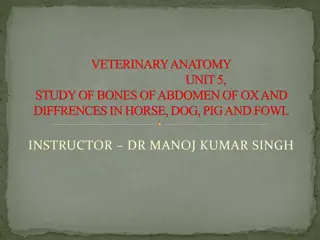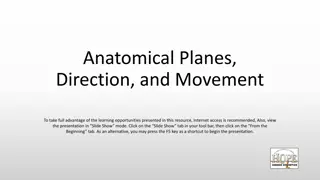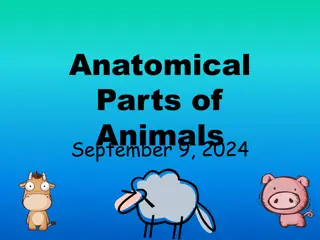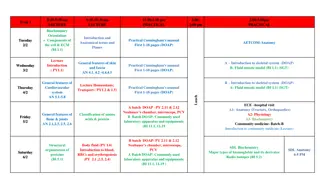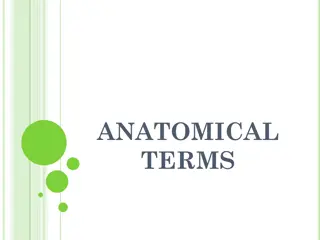$PDF$/READ Reflexology (Quick Study Academic)
\"COPY LINK HERE ; https:\/\/uyahsegoro.blogspot.com\/?book=1423228618\n\nPDF_ Reflexology (Quick Study Academic) | Zones associated with qi (chi or life force) used in the practice of Reflexology are mapped over anatomical illustrations of the surface anatomy of the hands, feet and ear to better l
1 views • 1 slides
Advances in Trans-Catheter Aortic Valve Replacement: A Comprehensive Review
This presentation explores the evolution of Trans-Catheter Aortic Valve Replacement (TAVR), highlighting historical milestones, anatomical considerations, the role of Balloon Aortic Valvuloplasty, current guidelines, the need for TAVI, and a notable case study by Dr. Cribier. The content discusses t
4 views • 85 slides
Anatomy of the Kidney: Essential Features and Functions
The kidneys play a vital role in filtering waste products, regulating electrolyte balance, maintaining blood pH, producing hormones, and more. This article explores the anatomical features of the kidneys, including their position, extent, internal structure, vascular segments, and coverings. It also
3 views • 16 slides
Radiographic Imaging Methods of the Respiratory System
Radiographic imaging plays a crucial role in the evaluation and diagnosis of thoraco-mediastino-pleuro-pulmonary conditions. Techniques like radioscopy, digital radiography, computer tomography, magnetic resonance imaging, conventional pulmonary angiography, and hybrid imaging methods offer detailed
11 views • 21 slides
The Urinary System: Anatomical Structures and Terms
This informative content delves into the anatomical structures and terms related to the urinary system, covering key components such as the kidneys, ureters, bladder, and urethra. It explains important terms like renal pyramids, calices, and ureter dexter/sinister, providing a comprehensive overview
1 views • 8 slides
Economic Aspects of Applied Plant Anatomy in Practical Use
Applied Plant Anatomy involves the practical application of anatomical knowledge in various fields such as identification, classification, taxonomic applications, medicinal plants, food safety, wood analysis, forensic investigations, and more. By understanding plant anatomy, professionals can utiliz
0 views • 26 slides
Analysis of Variance (ANOVA) for Testing Multiple Group Differences
Testing for differences among three or more groups can be effectively done using Analysis of Variance (ANOVA). By focusing on variance between means, ANOVA allows for comparison of multiple groups while avoiding issues of dependence and multiple comparisons. Sir Ronald Fisher's ANOVA method provides
1 views • 28 slides
Pelvic Anatomy in Veterinary Science
In this educational content, we delve into the intricate details of acetabulum, obturator foramen, pelvic cavity, pelvic inlet and outlet, sexual differences, and anatomical variations in sheep and goats. The explanations are accompanied by informative images to aid in better comprehension.
0 views • 19 slides
Comparative Study of Abdominal Bones in Various Animals
Study of the abdominal bones in the ox highlights characteristics like elongated transverse and curved articular processes, whereas differences in horse bones include shorter bodies and varying curvature of transverse processes. Understanding these anatomical variances provides insights into the uni
0 views • 16 slides
Anatomical Directions and Movements in Sports Medicine
Anatomical directions play a crucial role in explaining the precise location of body structures in relation to each other. They are utilized regardless of the actual position of the body, with terms like superior, inferior, anterior, posterior, medial, lateral, proximal, and distal aiding in clear c
0 views • 38 slides
Pediatric Surgery: Key Differences and Considerations
Pediatric surgery is a specialized field that differs significantly from general surgery due to unique anatomical and physiological aspects in children. This lecture covers key topics such as neonatal intestinal obstruction, atresia, and treatment approaches, highlighting the importance of tailored
0 views • 12 slides
Human Nature and Individual Differences in Foundation of Human Skills
Explore the foundational concepts of human behavior, individual differences, and organizational culture in the study of human skills. Delve into topics such as human nature, personality, attitudes, intelligence, and learning in Prof. Muskan Jeswani's course. Understand the significance of inter- and
0 views • 11 slides
Anatomical Planes, Directions, and Movement in Human Body
Explore the fundamentals of anatomical planes, direction, and movement in the human body. Learn about the three cardinal planes of motion, anatomical positions, directions, and their significance in describing body structures and movements. Gain insights into the anatomical position and how it relat
1 views • 35 slides
Anatomical Parts of Different Animals Visual Guide
Explore the detailed anatomical parts of various animals like dairy cow, hog, sheep, and more through informative images. Learn about the different body regions and components such as neck, rump, shoulder, hoof, and more.
0 views • 7 slides
Divergent Evolution of Nanotyrannus lancensis and Tyrannosaurus rex in the Hell Creek Formation
This content discusses the hypothetical divergent evolution of two apex predators, Nanotyrannus lancensis and Tyrannosaurus rex, from the Hell Creek Formation. It includes insights on their cranial osteology, tooth count, brain characteristics, and ontogeny, shedding light on their evolutionary path
0 views • 22 slides
Sequences and Patterns in Mathematics
Dive into the world of sequences and patterns by exploring expressions, common differences, and nth terms. Discover how to create sequences with specific common differences, identify terms within sequences, and use Venn diagrams to visualize different scenarios. Uncover the rules for constructing nt
0 views • 13 slides
Modernizing Organ Donation Laws: The Uniform Anatomical Gift Act of 2006
The Uniform Anatomical Gift Act (UAGA) of 2006 aims to enhance the donation process by introducing new definitions, emphasizing personal autonomy, and providing clearer rules. It addresses the need for uniformity, updates to reflect current practices, and modernizes the Act to ensure a smoother orga
0 views • 14 slides
Biochemistry Orientation, Cell Components, Anatomical Terms, and Practical Sessions Week 1
Delve into the world of Biochemistry with an orientation on cell components and the Extracellular Matrix (ECM). Explore anatomical terms and planes, setting the foundation for further learning. Engage in practical sessions using Cunningham's manual for hands-on experience in the field. Week 1 is pac
0 views • 38 slides
Pre-Lecture Material for Gross Anatomy: TBS and Anatomical Planes
Understand the Typical Body Segment (TBS) concept, a transverse section through the human body, and the importance of anatomical planes for orienting and dividing the body into sagittal, coronal, and transverse sections. Prepare effectively for Gross Anatomy lectures by grasping these foundational c
0 views • 6 slides
The Mediastinum: Boundaries, Divisions, and Contents
The mediastinum is a critical anatomical region in the thoracic cavity that houses various structures like the heart, thoracic vertebrae, diaphragm, and sternum. Divided into superior and inferior sections, it contains essential organs, vessels, nerves, and lymph nodes. Understanding its boundaries,
0 views • 25 slides
Anatomical Terminology Evolution: From Latin to Modern Standards
Anatomical terms have evolved over centuries into a unified nomenclature system known as Nomina anatomica. This system, initially based on Latin and Greek words, faced confusion and disagreement among anatomists, leading to revisions and the introduction of modern anatomical terminology. The structu
0 views • 27 slides
Essential Joint Motions and Anatomical Directions Explained
Explore various types of joint motions such as abduction, flexion, rotation, and more, along with anatomical directions like anterior, posterior, superior, and inferior. Understand the body's movements and positions with detailed illustrations in the anatomical context.
0 views • 10 slides
Gender Differences in Obedience Studies
Research studies on gender differences in obedience reveal varying levels of obedience between men and women. While some studies show similarities in obedience levels, others suggest potential differences attributed to factors like empathy and assertiveness. Contradictory findings exist, with some s
0 views • 9 slides
Comparative Anatomy of Horse and Human Bones at Whispering Oak Stables
Explore the detailed comparison of horse and human bones, highlighting the similarities and differences in their structure and function. From forelimbs to hind legs, discover homologous structures and learn how these anatomical features serve unique purposes in each species.
0 views • 11 slides
Human Evolution: Evidence of Common Ancestors
Explore evidence supporting the common ancestors for living hominids, including humans. Delve into phylogenetic trees, shared characteristics with African apes, and anatomical differences. Learn about the Hominidae family, genus Homo, and the terms "hominid" and "hominin.
0 views • 93 slides
Respiratory Tract Anatomy Overview
The respiratory tract anatomy includes various structures like mucosa, submucosa, and adventitia in the trachea, bronchi, bronchioles, and terminal bronchioles. Each component has specific compositions and functions, ranging from respiratory epithelium to smooth muscle layers. The images provide a v
0 views • 15 slides
The Orbital Region: An Overview
The orbital region encompasses the orbits, eyelids, ciliary and tarsal glands, and anatomical borders. It consists of bony cavities protecting the eyeballs, eyelids that shield the eyes, and intricate structures like the lacrimal apparatus and muscles. Understanding the components and anatomical rel
0 views • 15 slides
Pediatric Respiratory Infections: An Overview of Cases and Physiology
This review delves into selected cases of respiratory infections in children presented by Dr. David L. Smith, focusing on the anatomical and physiological aspects of the pediatric airway and respiratory system. It discusses respiratory failure in infants and small children, metabolic demands, cyanos
0 views • 49 slides
Veterinary Rib Resection Surgery Overview
Rib resection is a surgical procedure that involves the removal of one or more ribs to facilitate thoracic surgery in animals. This procedure is commonly indicated for conditions like osteosarcoma, chondrosarcoma, and rib fractures. The surgery requires making an elliptical incision, excising the ri
0 views • 8 slides
Evaluating Differences Between Psychedelic Drug Users and Non-Psychedelic Drug Users Among College Students
This study investigates the differences between college students who use psychedelic drugs and those who do not. It explores the potential therapeutic benefits of psychedelic-assisted therapy, the classification of different psychedelic substances, and the need for research on recreational psychedel
0 views • 10 slides
Introduction to Anatomy: Anatomical Terms and Skeletal System
An introduction to anatomy covering anatomical terms and the skeletal system. It defines anatomy, explains anatomical sciences, discusses the skeletal system, and outlines anatomical terminology including terms of position. The content includes objectives, classifications of bones, and different ana
0 views • 28 slides
Analyzing ATM-LVIS Difference Statistics for Greenland
The presentation discusses the analysis of ATM-LVIS difference statistics for Greenland, highlighting proposed processing refinements that are expected to have a minimal impact. The data editing process for ATM and LVIS measurements, histogram of slope-corrected differences, differences by slope and
0 views • 10 slides
Analysis of E/p Position Changes in Particle Reconstructed Energy Over Time
In the analysis of E/p position changes for electron, proton, and helium particles over time, a noticeable increase in the E/p peak position for electrons was observed, while the E/p peak positions for protons and helium remained relatively stable, especially for EnergyD. The changes observed after
0 views • 23 slides
Overview of Finite Difference Methods in Computational Fluid Dynamics
Discretization of equations is crucial in CFD, and Finite Difference Methods play a key role. Utilizing Taylor series, forward differences, rearward differences, and central differences, these methods transform partial differential equations into solvable algebraic forms. Understanding these techniq
0 views • 32 slides
Anatomical Terminology: Prefixes, Suffixes, and Roots
Explore the fundamentals of anatomical terminology by delving into prefixes, suffixes, and roots. Learn how these components modify and define medical terms, with examples and visuals to aid comprehension.
0 views • 12 slides
Anatomical Terminology Practice Exam: Body Regions and Landmarks
Test your knowledge of anatomical terminology by identifying various body regions and landmarks in this interactive practice exam. Practice naming cranial, cervical, thoracic, pubic, pectoral, axillary, brachial, and antecubital regions with the help of visual aids. Improve your understanding of ana
0 views • 32 slides
The Anatomy of the Hand and Wrist
Explore the bones, articulations, and structures of the hand and wrist, including carpal bones, flexor and extensor retinaculum, and carpal tunnel. Learn about the anatomical snuff box, wrist retinacula, nervous and arterial distribution, and the resting and anatomical position of the hand. Detailed
0 views • 20 slides
Terminology
The fundamentals of anatomical terminology including prefixes, suffixes, and roots. Learn how these components modify and define medical terms, aiding in better understanding of anatomical structures and functions. Discover common examples and applications to enhance your grasp of medical terminolog
0 views • 15 slides
Neuropsychological and Brain Volume Differences in Corticobasal Syndrome Patients
This study investigates differences in left and right beginning Corticobasal Syndrome (CBS) patients regarding brain volume and cognitive functions. Research reveals unique patterns of atrophy, cognitive impairment, and motor functions in l-CBS and r-CBS individuals. Understanding these differences
0 views • 7 slides
Anatomical Parts of livestock
Explore the anatomical parts of various livestock species, including cows, hogs, sheep, and beef cattle. The detailed images depict key body parts such as neck, rump, hoof, shoulder, and more. Learn about the structure and terminology used in livestock anatomy.
0 views • 5 slides








